check engine HONDA CR-V 2016 RM1, RM3, RM4 / 4.G Quick Guide
[x] Cancel search | Manufacturer: HONDA, Model Year: 2016, Model line: CR-V, Model: HONDA CR-V 2016 RM1, RM3, RM4 / 4.GPages: 80, PDF Size: 7.99 MB
Page 65 of 80
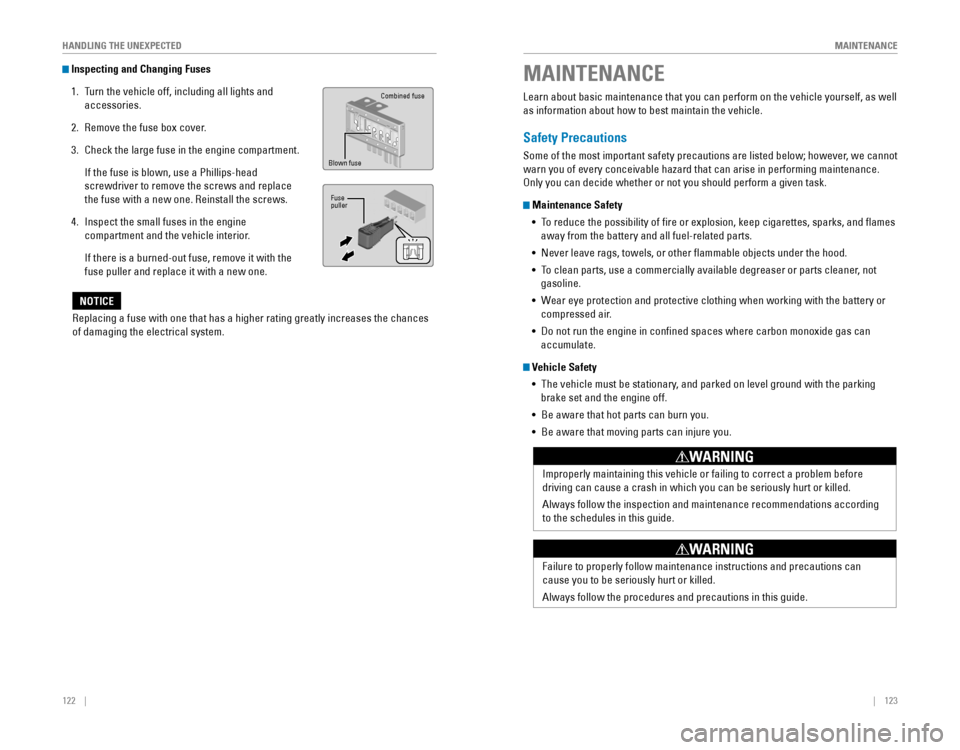
122 || 123
MAINTENANCE
HANDLING THE UNEXPECTED
Inspecting and Changing Fuses
1. Turn the vehicle off, including all lights and
accessories.
2. Remove‚ÄÇthe‚ÄÇfuse‚ÄÇbox‚ÄÇcover.
3. Check the large fuse in the engine compartment.
‚ÄÇIf‚ÄÇthe‚ÄÇfuse‚ÄÇis‚ÄÇblown,‚ÄÇuse‚ÄÇa‚ÄÇPhillips-head‚ÄÇ
screwdriver to remove the screws and replace
the fuse with a new one. Reinstall the screws.
4.‚ÄÇInspect‚ÄÇthe‚ÄÇsmall‚ÄÇfuses‚ÄÇin‚ÄÇthe‚ÄÇengine‚ÄÇ
compartment and the vehicle interior.
‚ÄÇIf‚ÄÇthere‚ÄÇis‚ÄÇa‚ÄÇburned-out‚ÄÇfuse,‚ÄÇremove‚ÄÇit‚ÄÇwith‚ÄÇthe‚ÄÇ
fuse puller and replace it with a new one.
Replacing a fuse with one that has a higher rating greatly increases the\
chances
of damaging the electrical system.
NOTICE
Blown fuse
Combined‚ÄÇfuse
Fuse
puller
Learn‚ÄÇabout‚ÄÇbasic‚ÄÇmaintenance‚ÄÇthat‚ÄÇyou‚ÄÇcan‚ÄÇperform‚ÄÇon‚ÄÇthe‚ÄÇvehicle‚ÄÇyourself,‚ÄÇas‚ÄÇwell‚ÄÇ
as‚ÄÇinformation‚ÄÇabout‚ÄÇhow‚ÄÇto‚ÄÇbest‚ÄÇmaintain‚ÄÇthe‚ÄÇvehicle.
Safety Precautions
Some‚ÄÇof‚ÄÇthe‚ÄÇmost‚ÄÇimportant‚ÄÇsafety‚ÄÇprecautions‚ÄÇare‚ÄÇlisted‚ÄÇbelow;‚ÄÇhowever,‚ÄÇwe‚ÄÇcannot‚ÄÇ
warn‚ÄÇyou‚ÄÇof‚ÄÇevery‚ÄÇconceivable‚ÄÇhazard‚ÄÇthat‚ÄÇcan‚ÄÇarise‚ÄÇin‚ÄÇperforming‚ÄÇmaintenance.‚ÄÇ
Only you can decide whether or not you should perform a given task.
Maintenance Safety • 
To‚ÄÇreduce‚ÄÇthe‚ÄÇpossibility‚ÄÇof‚ÄÇfire‚ÄÇor‚ÄÇexplosion,‚ÄÇkeep‚ÄÇcigarettes,‚ÄÇsparks,‚ÄÇand‚ÄÇflames‚ÄÇ
away‚ÄÇfrom‚ÄÇthe‚ÄÇbattery‚ÄÇand‚ÄÇall‚ÄÇfuel-related‚ÄÇparts.
• Never leave rags, towels, or other flammable objects under the hood.
• To clean parts, use a commercially available degreaser or parts cleaner, not 
gasoline.
• 
Wear‚ÄÇeye‚ÄÇprotection‚ÄÇand‚ÄÇprotective‚ÄÇclothing‚ÄÇwhen‚ÄÇworking‚ÄÇwith‚ÄÇthe‚ÄÇbattery‚ÄÇor‚ÄÇ
compressed air.
• 
Do‚ÄÇnot‚ÄÇrun‚ÄÇthe‚ÄÇengine‚ÄÇin‚ÄÇconfined‚ÄÇspaces‚ÄÇwhere‚ÄÇcarbon‚ÄÇmonoxide‚ÄÇgas‚ÄÇcan‚ÄÇ
accumulate.
Vehicle Safety • 
The‚ÄÇvehicle‚ÄÇmust‚ÄÇbe‚ÄÇstationary,‚ÄÇand‚ÄÇparked‚ÄÇon‚ÄÇlevel‚ÄÇground‚ÄÇwith‚ÄÇthe‚ÄÇparking‚ÄÇ
brake‚ÄÇset‚ÄÇand‚ÄÇthe‚ÄÇengine‚ÄÇoff.
• Be aware that hot parts can burn you.
•  Be aware that moving parts can injure you.
MAINTENANCE
Improperly‚ÄÇmaintaining‚ÄÇthis‚ÄÇvehicle‚ÄÇor‚ÄÇfailing‚ÄÇto‚ÄÇcorrect‚ÄÇa‚ÄÇproblem‚ÄÇbefore‚ÄÇ
driving‚ÄÇcan‚ÄÇcause‚ÄÇa‚ÄÇcrash‚ÄÇin‚ÄÇwhich‚ÄÇyou‚ÄÇcan‚ÄÇbe‚ÄÇseriously‚ÄÇhurt‚ÄÇor‚ÄÇkilled.‚ÄÇ
Always follow the inspection and maintenance recommendations according
to the schedules in this guide.
WARNING
Failure to properly follow maintenance instructions and precautions can \
cause‚ÄÇyou‚ÄÇto‚ÄÇbe‚ÄÇseriously‚ÄÇhurt‚ÄÇor‚ÄÇkilled.
Always follow the procedures and precautions in this guide.
WARNING
Page 66 of 80
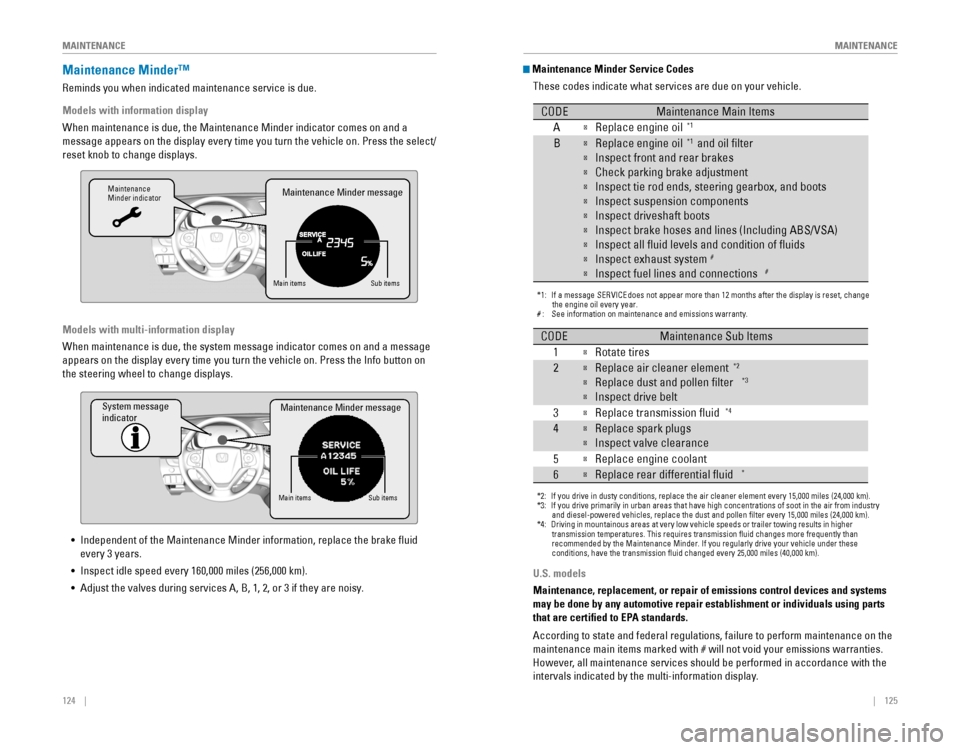
124‚ÄÇ‚ÄÇ‚ÄÇ‚ÄÇ|| 125
MAINTENANCE
MAINTENANCE
Maintenance Minder‚Ñ¢
Reminds you when indicated maintenance service is due.
Models with information display
When maintenance is due, the Maintenance Minder indicator comes on and a\
message‚ÄÇappears‚ÄÇon‚ÄÇthe‚ÄÇdisplay‚ÄÇevery‚ÄÇtime‚ÄÇyou‚ÄÇturn‚ÄÇthe‚ÄÇvehicle‚ÄÇon.‚ÄÇPress‚ÄÇthe‚ÄÇselect/
reset‚ÄÇknob‚ÄÇto‚ÄÇchange‚ÄÇdisplays.
Maintenance
Minder indicator
Main itemsSub‚ÄÇitems
Maintenance Minder message
Models with multi-information display
When maintenance is due, the system message indicator comes on and a mes\
sage
appears‚ÄÇon‚ÄÇthe‚ÄÇdisplay‚ÄÇevery‚ÄÇtime‚ÄÇyou‚ÄÇturn‚ÄÇthe‚ÄÇvehicle‚ÄÇon.‚ÄÇPress‚ÄÇthe‚ÄÇInfo‚ÄÇbutton‚ÄÇon‚ÄÇ
the steering wheel to change displays.
System message
indicator
Main itemsSub‚ÄÇitems
Maintenance Minder message
• Independent of the Maintenance Minder information, replace the brake fluid 
every 3 years.
• 
Inspect‚ÄÇidle‚ÄÇspeed‚ÄÇevery‚ÄÇ160,000‚ÄÇmiles‚ÄÇ(256,000‚ÄÇkm).
•  Adjust the valves during services A, B, 1, 2, or 3 if they are noisy.
U.S. models
Maintenance, replacement, or repair of emissions control devices and sys\
tems
may be done by any automotive repair establishment or individuals using \
parts
that are certified to EPA standards.
According to state and federal regulations, failure to perform maintenan\
ce on the
maintenance main items marked with # will not void your emissions warranties.
However,‚ÄÇall‚ÄÇmaintenance‚ÄÇservices‚ÄÇshould‚ÄÇbe‚ÄÇperformed‚ÄÇin‚ÄÇaccordance‚ÄÇwith‚ÄÇthe‚ÄÇ
intervals‚ÄÇindicated‚ÄÇby‚ÄÇthe‚ÄÇmulti-information‚ÄÇdisplay.
Maintenance Minder Service Codes
These codes indicate what services are due on your vehicle.
*1: If a message SERVICE does not appear more than 12 months after the display is reset, change \
the engine oil every year.
#: See information on maintenance and emissions warranty.
CODEMaintenance Main Items
A
�Replace engine oi l*1
B�Replace engine oil*1 and oil �lter
�Inspect front and rear brakes
�Check parking brake adjustment
�Inspect tie rod ends, steering gearbox, and boots
�Inspect suspension components
�Inspect driveshaft boots
�Inspect brake hoses and lines (Including ABS/VSA)
�Inspect all �uid levels and condition of �uids
�Inspect exhaust system#
�Inspect fuel lines and connections#
*2: If you drive in dusty conditions, replace the air cleaner element every \
15,000 miles (24,000 km).
*3: If you drive primarily in urban areas that have high concentrations of s\
oot in the air from industry and diesel-powered vehicles, replace the dust and pollen �lter every \
15,000 miles (24,000 km).
*4: Driving in mountainous areas at very low vehicle speeds or trailer towing results in higher
transmission temperatures. This requires transmission �uid changes mo\
re frequently than
recommended by the Maintenance Minder. If you regularly drive your vehic\
le under these
conditions, have the transmission �uid changed every 25,000 miles (4\
0,000 km).
CODEMaintenance Sub Items
1
�Rotate tires
2�Replace air cleaner element*2
�Replace dust and pollen �lter*3
�Inspect drive belt
3
�Replace transmission �uid*4
4�Replace spark plug s
�Inspect valve clearance
5
�Replace engine coolant
6�Replace rear differential �uid*
Page 67 of 80
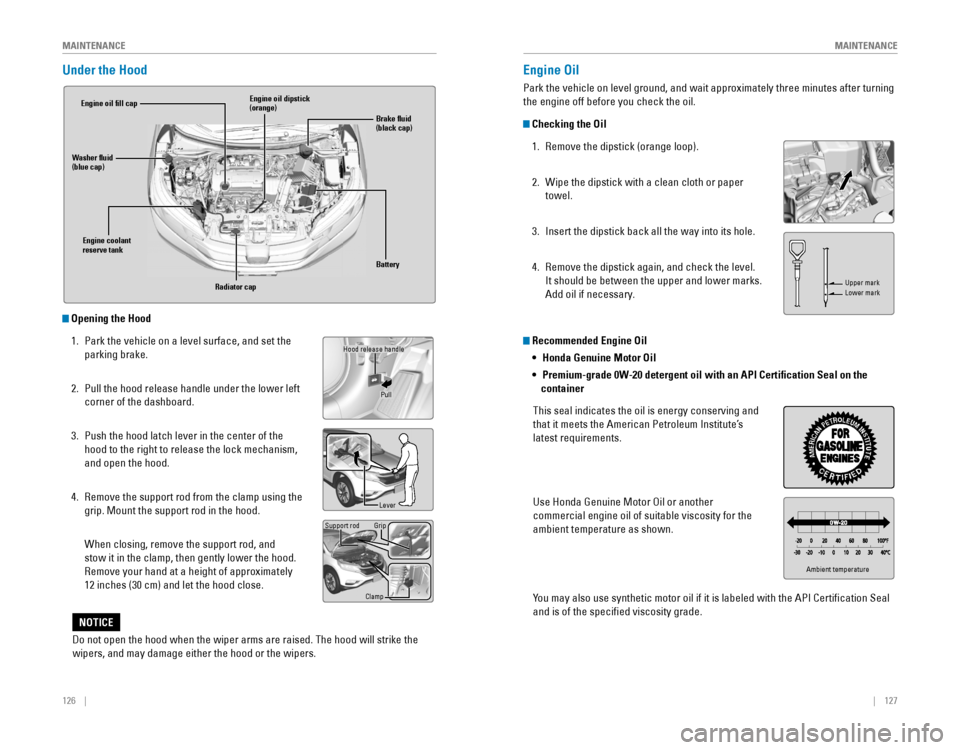
126 ||‚ÄÇ‚ÄÇ‚ÄÇ‚ÄÇ127
MAINTENANCE
MAINTENANCE
Under the Hood
Opening the Hood
1. Park the vehicle on a level surface, and set the
parking‚ÄÇbrake.
2. Pull the hood release handle under the lower left
corner‚ÄÇof‚ÄÇthe‚ÄÇdashboard.
3. Push the hood latch lever in the center of the
hood to the right to release the lock mechanism,
and open the hood.
4.‚ÄÇRemove the support rod from the clamp using the
grip. Mount the support rod in the hood.
When closing, remove the support rod, and
stow it in the clamp, then gently lower the hood.
Remove your hand at a height of approximately
12 inches (30 cm) and let the hood close.
Engine coolant
reserve tank
Washer fluid
(blue cap)
Engine oil fill cap
Engine oil dipstick
(orange)
Brake fluid
(black cap)
Battery
Radiator cap
Hood release handle
Lever
Support rod Grip
ClampPull
Do‚ÄÇnot‚ÄÇopen‚ÄÇthe‚ÄÇhood‚ÄÇwhen‚ÄÇthe‚ÄÇwiper‚ÄÇarms‚ÄÇare‚ÄÇraised.‚ÄÇThe‚ÄÇhood‚ÄÇwill‚ÄÇstrike‚ÄÇthe‚ÄÇ
wipers, and may damage either the hood or the wipers.
NOTICE
Recommended Engine Oil
• 
Honda Genuine Motor Oil
•  Premium-grade 0W-20 detergent oil with an API Certification Seal on the
container
This seal indicates the oil is energy conserving and
that it meets the American Petroleum Institute’s 
latest‚ÄÇrequirements.
Use Honda Genuine Motor Oil or another
commercial‚ÄÇengine‚ÄÇoil‚ÄÇof‚ÄÇsuitable‚ÄÇviscosity‚ÄÇfor‚ÄÇthe‚ÄÇ
ambient‚ÄÇtemperature‚ÄÇas‚ÄÇshown.
You‚ÄÇmay‚ÄÇalso‚ÄÇuse‚ÄÇsynthetic‚ÄÇmotor‚ÄÇoil‚ÄÇif‚ÄÇit‚ÄÇis‚ÄÇlabeled‚ÄÇwith‚ÄÇthe‚ÄÇAPI‚ÄÇCertification‚ÄÇSeal‚ÄÇ
and is of the specified viscosity grade.
Engine Oil
Park the vehicle on level ground, and wait approximately three minutes after turning
the‚ÄÇengine‚ÄÇoff‚ÄÇbefore‚ÄÇyou‚ÄÇcheck‚ÄÇthe‚ÄÇoil.
Checking the Oil
1. Remove the dipstick (orange loop).
2. Wipe the dipstick with a clean cloth or paper
towel.
3. Insert‚ÄÇthe‚ÄÇdipstick‚ÄÇback‚ÄÇall‚ÄÇthe‚ÄÇway‚ÄÇinto‚ÄÇits‚ÄÇhole.
4.‚ÄÇRemove the dipstick again, and check the level.
It‚ÄÇshould‚ÄÇbe‚ÄÇbetween‚ÄÇthe‚ÄÇupper‚ÄÇand‚ÄÇlower‚ÄÇmarks.‚ÄÇ
Add oil if necessary.
Ambient‚ÄÇtemperature
Upper mark
Lower mark
Page 68 of 80
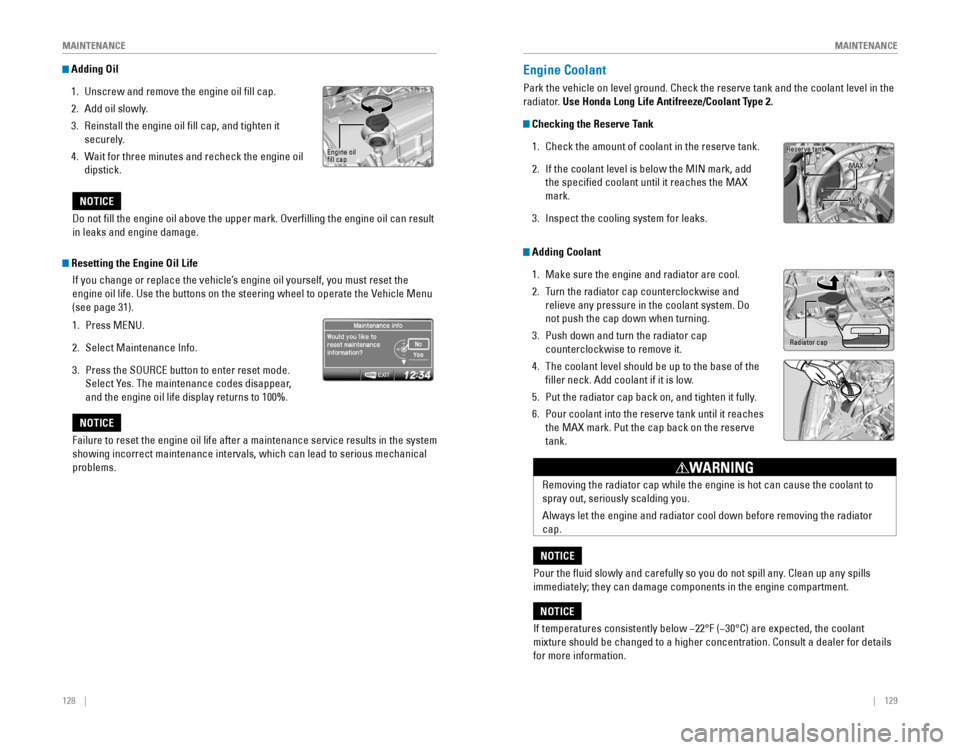
128 || 129
MAINTENANCE
MAINTENANCE
Adding Oil
1. Unscrew and remove the engine oil fill cap.
2. Add oil slowly.
3. Reinstall the engine oil fill cap, and tighten it
securely.
4.‚ÄÇWait for three minutes and recheck the engine oil
dipstick.Engine‚ÄÇoil‚ÄÇfill cap
Do‚ÄÇnot‚ÄÇfill‚ÄÇthe‚ÄÇengine‚ÄÇoil‚ÄÇabove‚ÄÇthe‚ÄÇupper‚ÄÇmark.‚ÄÇOverfilling‚ÄÇthe‚ÄÇengine‚ÄÇoil‚ÄÇcan‚ÄÇresult‚ÄÇ
in leaks and engine damage.
NOTICE
Failure to reset the engine oil life after a maintenance service results\
in the system
showing incorrect maintenance intervals, which can lead to serious mecha\
nical
problems.
NOTICE
Resetting the Engine Oil Life
If you change or replace the vehicle’s engine oil yourself, you must reset the 
engine‚ÄÇoil‚ÄÇlife.‚ÄÇUse‚ÄÇthe‚ÄÇbuttons‚ÄÇon‚ÄÇthe‚ÄÇsteering‚ÄÇwheel‚ÄÇto‚ÄÇoperate‚ÄÇthe‚ÄÇVehicle‚ÄÇMenu‚ÄÇ
(see page 31).
1. Press‚ÄÇMENU.
2. Select‚ÄÇMaintenance‚ÄÇInfo.
3. Press‚ÄÇthe‚ÄÇSOURCE‚ÄÇbutton‚ÄÇto‚ÄÇenter‚ÄÇreset‚ÄÇmode.
Select Yes. The maintenance codes disappear,
and‚ÄÇthe‚ÄÇengine‚ÄÇoil‚ÄÇlife‚ÄÇdisplay‚ÄÇreturns‚ÄÇto‚ÄÇ100%.
Engine Coolant
Park the vehicle on level ground. Check the reserve tank and the coolant\
level in the
radiator. Use Honda Long Life Antifreeze/Coolant Type 2.
Checking the Reserve Tank
1. Check the amount of coolant in the reserve tank.
2. If‚ÄÇthe‚ÄÇcoolant‚ÄÇlevel‚ÄÇis‚ÄÇbelow‚ÄÇthe‚ÄÇMIN‚ÄÇmark,‚ÄÇadd‚ÄÇ
the specified coolant until it reaches the MAX
mark.
3. Inspect‚ÄÇthe‚ÄÇcooling‚ÄÇsystem‚ÄÇfor‚ÄÇleaks.
If temperatures consistently below −22°F (−30°C) are expected, the coolant 
mixture‚ÄÇshould‚ÄÇbe‚ÄÇchanged‚ÄÇto‚ÄÇa‚ÄÇhigher‚ÄÇconcentration.‚ÄÇConsult‚ÄÇa‚ÄÇdealer‚ÄÇfor‚ÄÇdetails‚ÄÇ
for more information.
NOTICE
Reserve tank
MAX
MIN
Removing the radiator cap while the engine is hot can cause the coolant \
to
spray out, seriously scalding you.
Always‚ÄÇlet‚ÄÇthe‚ÄÇengine‚ÄÇand‚ÄÇradiator‚ÄÇcool‚ÄÇdown‚ÄÇbefore‚ÄÇremoving‚ÄÇthe‚ÄÇradiator‚ÄÇ
cap.
WARNING
Pour the fluid slowly and carefully so you do not spill any. Clean up any spills
immediately; they can damage components in the engine compartment.
NOTICE
Adding Coolant
1. Make sure the engine and radiator are cool.
2. Turn the radiator cap counterclockwise and
relieve‚ÄÇany‚ÄÇpressure‚ÄÇin‚ÄÇthe‚ÄÇcoolant‚ÄÇsystem.‚ÄÇDo‚ÄÇ
not push the cap down when turning.
3. Push down and turn the radiator cap
counterclockwise to remove it.
4.‚ÄÇThe‚ÄÇcoolant‚ÄÇlevel‚ÄÇshould‚ÄÇbe‚ÄÇup‚ÄÇto‚ÄÇthe‚ÄÇbase‚ÄÇof‚ÄÇthe‚ÄÇ
filler neck. Add coolant if it is low.
5. Put‚ÄÇthe‚ÄÇradiator‚ÄÇcap‚ÄÇback‚ÄÇon,‚ÄÇand‚ÄÇtighten‚ÄÇit‚ÄÇfully.
6. Pour coolant into the reserve tank until it reaches
the‚ÄÇMAX‚ÄÇmark.‚ÄÇPut‚ÄÇthe‚ÄÇcap‚ÄÇback‚ÄÇon‚ÄÇthe‚ÄÇreserve‚ÄÇ
tank.
Radiator cap
Page 69 of 80
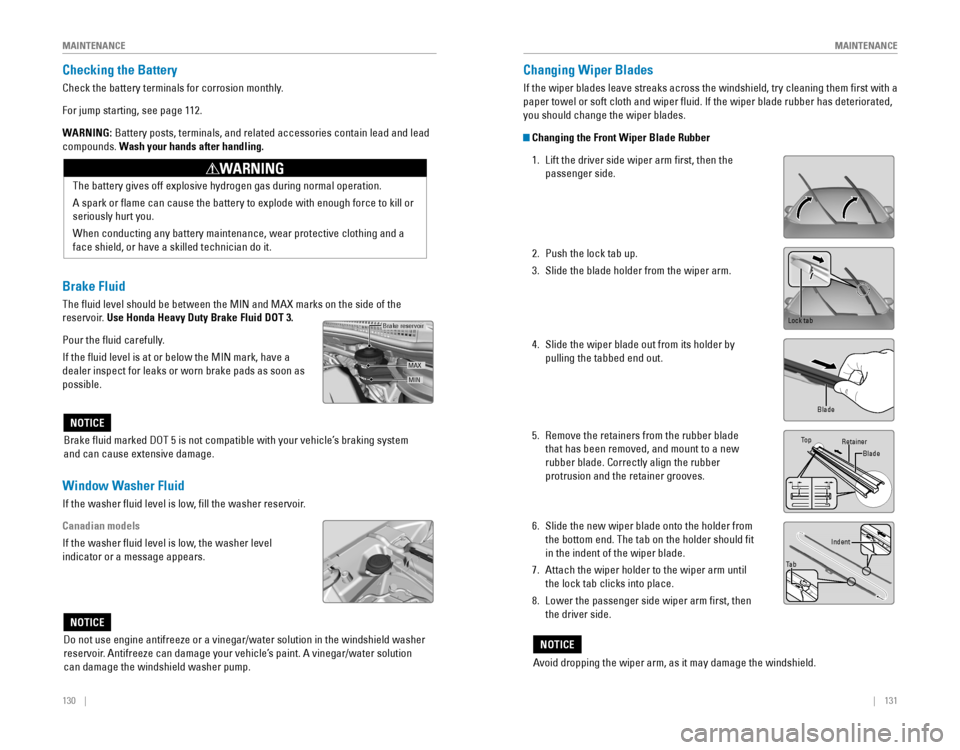
130 || 131
MAINTENANCE
MAINTENANCE
Checking the Battery
Check‚ÄÇthe‚ÄÇbattery‚ÄÇterminals‚ÄÇfor‚ÄÇcorrosion‚ÄÇmonthly.
For jump starting, see page 112.
WARNING: Battery posts, terminals, and related accessories contain lead and lead\
compounds. Wash your hands after handling.
The‚ÄÇbattery‚ÄÇgives‚ÄÇoff‚ÄÇexplosive‚ÄÇhydrogen‚ÄÇgas‚ÄÇduring‚ÄÇnormal‚ÄÇoperation.
A‚ÄÇspark‚ÄÇor‚ÄÇflame‚ÄÇcan‚ÄÇcause‚ÄÇthe‚ÄÇbattery‚ÄÇto‚ÄÇexplode‚ÄÇwith‚ÄÇenough‚ÄÇforce‚ÄÇto‚ÄÇkill‚ÄÇor‚ÄÇ
seriously hurt you.
When‚ÄÇconducting‚ÄÇany‚ÄÇbattery‚ÄÇmaintenance,‚ÄÇwear‚ÄÇprotective‚ÄÇclothing‚ÄÇand‚ÄÇa‚ÄÇ
face shield, or have a skilled technician do it.
WARNING
Do‚ÄÇnot‚ÄÇuse‚ÄÇengine‚ÄÇantifreeze‚ÄÇor‚ÄÇa‚ÄÇvinegar/water‚ÄÇsolution‚ÄÇin‚ÄÇthe‚ÄÇwindshield‚ÄÇwasher‚ÄÇ
reservoir. Antifreeze can damage your vehicle’s paint. A vinegar/water solution 
can damage the windshield washer pump.
NOTICE
Window Washer Fluid
If‚ÄÇthe‚ÄÇwasher‚ÄÇfluid‚ÄÇlevel‚ÄÇis‚ÄÇlow,‚ÄÇfill‚ÄÇthe‚ÄÇwasher‚ÄÇreservoir.‚ÄÇ
Canadian models
If‚ÄÇthe‚ÄÇwasher‚ÄÇfluid‚ÄÇlevel‚ÄÇis‚ÄÇlow,‚ÄÇthe‚ÄÇwasher‚ÄÇlevel‚ÄÇ
indicator or a message appears.
Changing Wiper Blades
If‚ÄÇthe‚ÄÇwiper‚ÄÇblades‚ÄÇleave‚ÄÇstreaks‚ÄÇacross‚ÄÇthe‚ÄÇwindshield,‚ÄÇtry‚ÄÇcleaning‚ÄÇthem‚ÄÇfirst‚ÄÇwith‚ÄÇa‚ÄÇ
paper‚ÄÇtowel‚ÄÇor‚ÄÇsoft‚ÄÇcloth‚ÄÇand‚ÄÇwiper‚ÄÇfluid.‚ÄÇIf‚ÄÇthe‚ÄÇwiper‚ÄÇblade‚ÄÇrubber‚ÄÇhas‚ÄÇdeteriorated,‚ÄÇ
you‚ÄÇshould‚ÄÇchange‚ÄÇthe‚ÄÇwiper‚ÄÇblades.
Changing the Front Wiper Blade Rubber
1. Lift the driver side wiper arm first, then the
passenger side.
2. Push‚ÄÇthe‚ÄÇlock‚ÄÇtab‚ÄÇup.‚ÄÇ
3. Slide‚ÄÇthe‚ÄÇblade‚ÄÇholder‚ÄÇfrom‚ÄÇthe‚ÄÇwiper‚ÄÇarm.
4.‚ÄÇSlide‚ÄÇthe‚ÄÇwiper‚ÄÇblade‚ÄÇout‚ÄÇfrom‚ÄÇits‚ÄÇholder‚ÄÇby‚ÄÇ
pulling‚ÄÇthe‚ÄÇtabbed‚ÄÇend‚ÄÇout.
5. Remove‚ÄÇthe‚ÄÇretainers‚ÄÇfrom‚ÄÇthe‚ÄÇrubber‚ÄÇblade‚ÄÇ
that‚ÄÇhas‚ÄÇbeen‚ÄÇremoved,‚ÄÇand‚ÄÇmount‚ÄÇto‚ÄÇa‚ÄÇnew‚ÄÇ
rubber‚ÄÇblade.‚ÄÇCorrectly‚ÄÇalign‚ÄÇthe‚ÄÇrubber‚ÄÇ
protrusion and the retainer grooves.
6. Slide‚ÄÇthe‚ÄÇnew‚ÄÇwiper‚ÄÇblade‚ÄÇonto‚ÄÇthe‚ÄÇholder‚ÄÇfrom‚ÄÇ
the‚ÄÇbottom‚ÄÇend.‚ÄÇThe‚ÄÇtab‚ÄÇon‚ÄÇthe‚ÄÇholder‚ÄÇshould‚ÄÇfit‚ÄÇ
in‚ÄÇthe‚ÄÇindent‚ÄÇof‚ÄÇthe‚ÄÇwiper‚ÄÇblade.
7.‚ÄÇAttach the wiper holder to the wiper arm until
the‚ÄÇlock‚ÄÇtab‚ÄÇclicks‚ÄÇinto‚ÄÇplace.
8. Lower the passenger side wiper arm first, then
the driver side.
Lock‚ÄÇtab
Blade
To p Retainer
Blade
Ta b Indent
Avoid dropping the wiper arm, as it may damage the windshield.
NOTICE
Brake fluid marked DOT 5 is not compatible with your vehicle’s braking system 
and can cause extensive damage.
NOTICE
Brake Fluid
The‚ÄÇfluid‚ÄÇlevel‚ÄÇshould‚ÄÇbe‚ÄÇbetween‚ÄÇthe‚ÄÇMIN‚ÄÇand‚ÄÇMAX‚ÄÇmarks‚ÄÇon‚ÄÇthe‚ÄÇside‚ÄÇof‚ÄÇthe‚ÄÇ
reservoir. Use Honda Heavy Duty Brake Fluid DOT 3.
Pour the fluid carefully.
If‚ÄÇthe‚ÄÇfluid‚ÄÇlevel‚ÄÇis‚ÄÇat‚ÄÇor‚ÄÇbelow‚ÄÇthe‚ÄÇMIN‚ÄÇmark,‚ÄÇhave‚ÄÇa‚ÄÇ
dealer‚ÄÇinspect‚ÄÇfor‚ÄÇleaks‚ÄÇor‚ÄÇworn‚ÄÇbrake‚ÄÇpads‚ÄÇas‚ÄÇsoon‚ÄÇas‚ÄÇ
possible.
Brake reservoir
MIN
MAX
Page 73 of 80
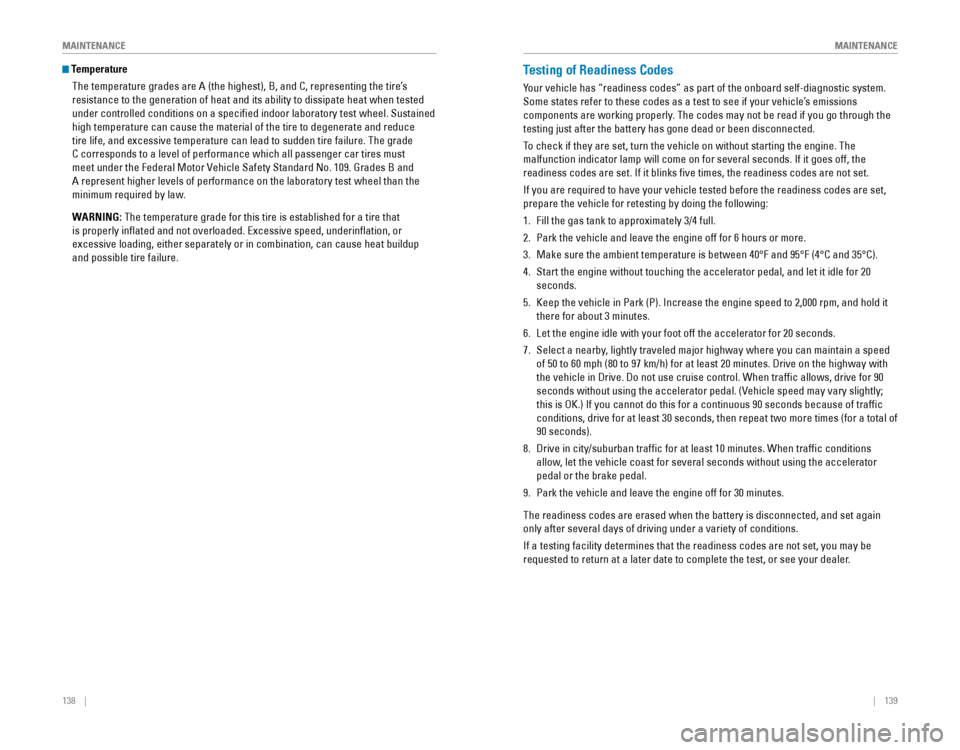
138 || 139
MAINTENANCE
MAINTENANCE
Temperature
The temperature grades are A (the highest), B, and C, representing the\
tire’s
resistance‚ÄÇto‚ÄÇthe‚ÄÇgeneration‚ÄÇof‚ÄÇheat‚ÄÇand‚ÄÇits‚ÄÇability‚ÄÇto‚ÄÇdissipate‚ÄÇheat‚ÄÇwhen‚ÄÇtested‚ÄÇ
under‚ÄÇcontrolled‚ÄÇconditions‚ÄÇon‚ÄÇa‚ÄÇspecified‚ÄÇindoor‚ÄÇlaboratory‚ÄÇtest‚ÄÇwheel.‚ÄÇSustained‚ÄÇ
high temperature can cause the material of the tire to degenerate and re\
duce
tire life, and excessive temperature can lead to sudden tire failure. Th\
e grade
C corresponds to a level of performance which all passenger car tires must
meet under the Federal Motor Vehicle Safety Standard No. 109. Grades B and
A‚ÄÇrepresent‚ÄÇhigher‚ÄÇlevels‚ÄÇof‚ÄÇperformance‚ÄÇon‚ÄÇthe‚ÄÇlaboratory‚ÄÇtest‚ÄÇwheel‚ÄÇthan‚ÄÇthe‚ÄÇ
minimum‚ÄÇrequired‚ÄÇby‚ÄÇlaw.
WARNING:‚ÄÇThe‚ÄÇtemperature‚ÄÇgrade‚ÄÇfor‚ÄÇthis‚ÄÇtire‚ÄÇis‚ÄÇestablished‚ÄÇfor‚ÄÇa‚ÄÇtire‚ÄÇthat‚ÄÇ
is‚ÄÇproperly‚ÄÇinflated‚ÄÇand‚ÄÇnot‚ÄÇoverloaded.‚ÄÇExcessive‚ÄÇspeed,‚ÄÇunderinflation,‚ÄÇor‚ÄÇ
excessive‚ÄÇloading,‚ÄÇeither‚ÄÇseparately‚ÄÇor‚ÄÇin‚ÄÇcombination,‚ÄÇcan‚ÄÇcause‚ÄÇheat‚ÄÇbuildup‚ÄÇ
and‚ÄÇpossible‚ÄÇtire‚ÄÇfailure.
Testing of Readiness Codes
Your vehicle has “readiness codes” as part of the onboard self-diagnostic system. 
Some states refer to these codes as a test to see if your vehicle’s emissions
components‚ÄÇare‚ÄÇworking‚ÄÇproperly.‚ÄÇThe‚ÄÇcodes‚ÄÇmay‚ÄÇnot‚ÄÇbe‚ÄÇread‚ÄÇif‚ÄÇyou‚ÄÇgo‚ÄÇthrough‚ÄÇthe‚ÄÇ
testing‚ÄÇjust‚ÄÇafter‚ÄÇthe‚ÄÇbattery‚ÄÇhas‚ÄÇgone‚ÄÇdead‚ÄÇor‚ÄÇbeen‚ÄÇdisconnected.
To check if they are set, turn the vehicle on without starting the engine\
. The
malfunction‚ÄÇindicator‚ÄÇlamp‚ÄÇwill‚ÄÇcome‚ÄÇon‚ÄÇfor‚ÄÇseveral‚ÄÇseconds.‚ÄÇIf‚ÄÇit‚ÄÇgoes‚ÄÇoff,‚ÄÇthe‚ÄÇ
readiness‚ÄÇcodes‚ÄÇare‚ÄÇset.‚ÄÇIf‚ÄÇit‚ÄÇblinks‚ÄÇfive‚ÄÇtimes,‚ÄÇthe‚ÄÇreadiness‚ÄÇcodes‚ÄÇare‚ÄÇnot‚ÄÇset.
If‚ÄÇyou‚ÄÇare‚ÄÇrequired‚ÄÇto‚ÄÇhave‚ÄÇyour‚ÄÇvehicle‚ÄÇtested‚ÄÇbefore‚ÄÇthe‚ÄÇreadiness‚ÄÇcodes‚ÄÇare‚ÄÇset,‚ÄÇ
prepare‚ÄÇthe‚ÄÇvehicle‚ÄÇfor‚ÄÇretesting‚ÄÇby‚ÄÇdoing‚ÄÇthe‚ÄÇfollowing:
1. Fill‚ÄÇthe‚ÄÇgas‚ÄÇtank‚ÄÇto‚ÄÇapproximately‚ÄÇ3/4‚ÄÇfull.
2. Park the vehicle and leave the engine off for 6 hours or more.
3. Make sure the ambient temperature is between 40°F and 95°F (4°C and 35°C).
4.‚ÄÇStart the engine without touching the accelerator pedal, and let it idle\
for 20
seconds.
5. Keep‚ÄÇthe‚ÄÇvehicle‚ÄÇin‚ÄÇPark‚ÄÇ(P).‚ÄÇIncrease‚ÄÇthe‚ÄÇengine‚ÄÇspeed‚ÄÇto‚ÄÇ2,000‚ÄÇrpm,‚ÄÇand‚ÄÇhold‚ÄÇit‚ÄÇ
there‚ÄÇfor‚ÄÇabout‚ÄÇ3‚ÄÇminutes.
6. Let the engine idle with your foot off the accelerator for 20 seconds.
7.‚ÄÇSelect‚ÄÇa‚ÄÇnearby,‚ÄÇlightly‚ÄÇtraveled‚ÄÇmajor‚ÄÇhighway‚ÄÇwhere‚ÄÇyou‚ÄÇcan‚ÄÇmaintain‚ÄÇa‚ÄÇspeed‚ÄÇ
of‚ÄÇ50‚ÄÇto‚ÄÇ60‚ÄÇmph‚ÄÇ(80‚ÄÇto‚ÄÇ97‚ÄÇkm/h)‚ÄÇfor‚ÄÇat‚ÄÇleast‚ÄÇ20‚ÄÇminutes.‚ÄÇDrive‚ÄÇon‚ÄÇthe‚ÄÇhighway‚ÄÇwith‚ÄÇ
the‚ÄÇvehicle‚ÄÇin‚ÄÇDrive.‚ÄÇDo‚ÄÇnot‚ÄÇuse‚ÄÇcruise‚ÄÇcontrol.‚ÄÇWhen‚ÄÇtraffic‚ÄÇallows,‚ÄÇdrive‚ÄÇfor‚ÄÇ90‚ÄÇ
seconds without using the accelerator pedal. (Vehicle speed may vary slightly;
this‚ÄÇis‚ÄÇOK.)‚ÄÇIf‚ÄÇyou‚ÄÇcannot‚ÄÇdo‚ÄÇthis‚ÄÇfor‚ÄÇa‚ÄÇcontinuous‚ÄÇ90‚ÄÇseconds‚ÄÇbecause‚ÄÇof‚ÄÇtraffic‚ÄÇ
conditions, drive for at least 30 seconds, then repeat two more times (\
for a total of
90 seconds).
8. Drive‚ÄÇin‚ÄÇcity/suburban‚ÄÇtraffic‚ÄÇfor‚ÄÇat‚ÄÇleast‚ÄÇ10‚ÄÇminutes.‚ÄÇWhen‚ÄÇtraffic‚ÄÇconditions‚ÄÇ
allow, let the vehicle coast for several seconds without using the accelerator
pedal‚ÄÇor‚ÄÇthe‚ÄÇbrake‚ÄÇpedal.
9. Park the vehicle and leave the engine off for 30 minutes.
The‚ÄÇreadiness‚ÄÇcodes‚ÄÇare‚ÄÇerased‚ÄÇwhen‚ÄÇthe‚ÄÇbattery‚ÄÇis‚ÄÇdisconnected,‚ÄÇand‚ÄÇset‚ÄÇagain‚ÄÇ
only after several days of driving under a variety of conditions.
If‚ÄÇa‚ÄÇtesting‚ÄÇfacility‚ÄÇdetermines‚ÄÇthat‚ÄÇthe‚ÄÇreadiness‚ÄÇcodes‚ÄÇare‚ÄÇnot‚ÄÇset,‚ÄÇyou‚ÄÇmay‚ÄÇbe‚ÄÇ
requested‚ÄÇto‚ÄÇreturn‚ÄÇat‚ÄÇa‚ÄÇlater‚ÄÇdate‚ÄÇto‚ÄÇcomplete‚ÄÇthe‚ÄÇtest,‚ÄÇor‚ÄÇsee‚ÄÇyour‚ÄÇdealer.
Page 74 of 80
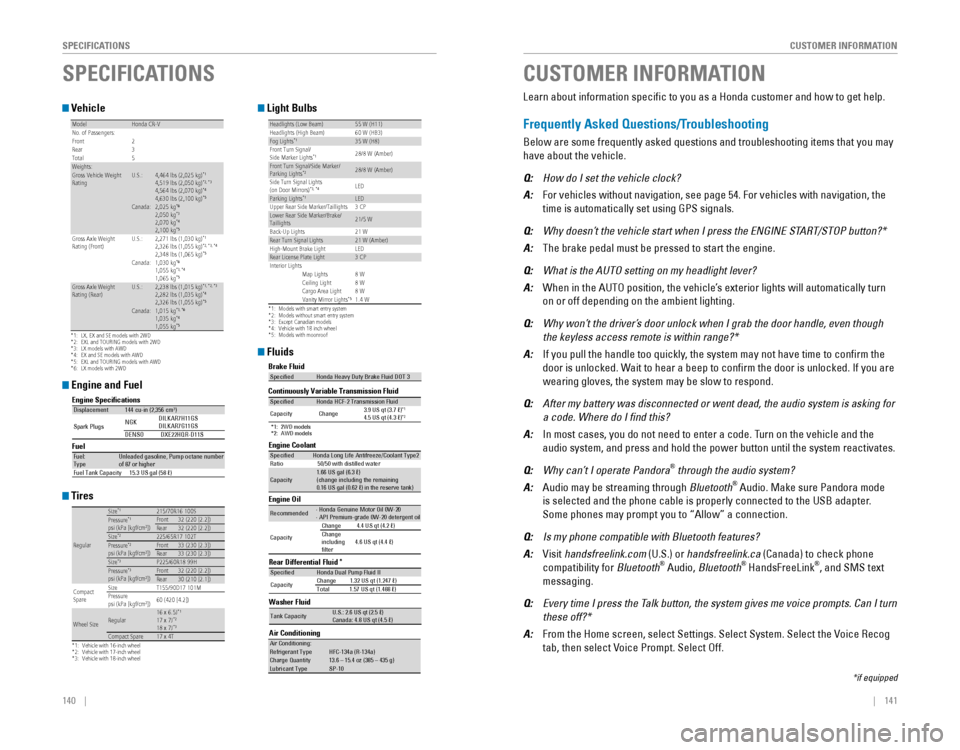
140‚ÄÇ‚ÄÇ‚ÄÇ‚ÄÇ||‚ÄÇ‚ÄÇ‚ÄÇ‚ÄÇ141
CUSTOMER INFORMATION
SPECIFICATIONS
Vehicle
*1:LX, EX and SE models with 2WD*2:EXL and TOURING models with 2WD*3:LX models with AWD*4:EX and SE models with AWD*5:EXL and TOURING models with AWD*6: LX models with 2WD
ModelHonda CR- VNo. of Passengers:
Front 2
Rear 3
Tota l5
Weights:Gross Vehicle Weight
Rating U.S.:4,464 lbs (2,025 kg )*14,519 lbs (2,050 kg)*2, *34,564 lbs (2,070 kg )*44,630 lbs (2,100 kg)*5Canada:2,025 kg*62,050 kg*32,070 kg*42,100 kg*5Gross Axle Weight
Rating (Front)U.S.:2,271 lbs (1,030 kg )*12,326 lbs (1,055 kg)*2, *3 , *42,348 lbs (1,065 kg )*5Canada:1,030 kg*61,055 kg*3, *41,065 kg*5Gross Axle Weight
Rating (Rear)U.S.:2,238 lbs (1,015 kg )*1, *2 , *32,282 lbs (1,035 kg )*42,326 lbs (1,055 kg)*5Canada:1,015 kg*3, *61,035 kg*41,055 kg*5
Engine and Fuel
Engine Speci�cation s
FuelDisplacemen t144 cu-in (2,356 cm3)
Spark Plugs NG
K DILKAR7H11GS
DILKAR7G11GS
DENSO DXE22HQR-D11 S
Fuel:
TypeUnleaded gasoline, Pump octane number of 87 or higher
Fuel Tank Capacity 15.3 US gal (58 �)
Tires
*1:Vehicle with 16-inch wheel*2:Vehicle with 17-inch wheel*3: Vehicle with 18-inch wheel
Regular
Size*1215/70R16 100 SPressure*1psi (k Pa [kgf/cm2])Front32 (220 [2.2])Rear32 (220 [2.2])Size*2225/65R17 102 TPressure*2psi (k Pa [kgf/cm2])Front33 (230 [2.3])Rear33 (230 [2.3])Size*3P225/60R18 99HPressure*3psi (k Pa [kgf/cm2])Front32 (220 [2.2])Rear30 (210 [2.1])
Compact
Spar e Size
T155/90D17 101M
Pr essure
psi (k Pa [kgf/cm
2])60 (420 [4.2])
Wheel SizeRegular16 x 6.5J*117 x 7J*218 x 7J*3Compact Spar
e17 x 4T
Light Bulbs
*1:Models with smart entry system*2:Models without smart entry system*3:Except Canadian models *4:Vehicle with 18 inch whee l*5: Models with moonroof
Headlights (Low Beam)55 W (H11 )Headlights (High Beam) 60 W (HB3)Fog Lights*135 W (H8)
Front Turn Signal/
Side Marker Light s
*128/8 W (Amber)
Front Turn Signal/Side Marker /
Parking Light s*228/8 W (Amber)
Side Turn Signal Lights
(on Door Mirrors )
*3, *4LED
Parking Light s*1LED
Upper Rear Side Marker/Taillight s3 CP
Lower Rear Side Marker/Brake/
Taillight s21/5 W
Back-Up Lights 21 W
Rear Turn Signal Light s21 W (Amber)
High- Mount Brak e LightL ED
Rear License Plate Light3 CP
In teri or Lights
Map Lights 8 W
Ceiling Light 8 W
Cargo Area Light 8 W
Vanity Mirror Lights
*51.4 W
Fluids
Washer Fluid
Tank Capacit yU.S.: 2.6 US qt (2.5 �)
Canada: 4.8 US qt (4.5 �)
Brake Fluid
Continuously Variable Transmission Fluid
*1: 2WD models
*2: AWD models
Rear Differential Fluid*
Speci�e dHonda Heavy Duty Brake Fluid DOT 3
Speci�edHonda HCF-2 Transmission Flui d
Capacity Change 3.9 US qt (3.7 �)*14.5 US qt (4.3 �)*2
Speci�e
dHonda Dual Pump Fluid II
Capacity Change
1.32 US qt (1.247 �)
Tota l1 .57 US qt (1.488 �)
Engine Oil
Engine Coolant
Recommende d· Honda Genuine Motor Oil 0W-2 0
· API Premium-grade 0W-20 detergent oi l
Capacity Change
4.4 US qt (4.2 �)
Change
including
�lter 4.6 US qt (4.4 �)
Speci�e
dHonda Long Life Anti freeze/Coolant Type 2
Ratio 50/50 with distilled wate r
Capacity1.66 US gal (6.3 �)
(change including the remaining
0.16 US gal (0.62 �) in the reserve tank )
Air ConditioningAir Conditioning:Refrigerant Type HFC-134a (R-134a)Charge Quantity13.6 – 15.4 oz (385 – 435 g)Lubricant TypeSP-10
SPECIFICATIONS
Learn‚ÄÇabout‚ÄÇinformation‚ÄÇspecific‚ÄÇto‚ÄÇyou‚ÄÇas‚ÄÇa‚ÄÇHonda‚ÄÇcustomer‚ÄÇand‚ÄÇhow‚ÄÇto‚ÄÇget‚ÄÇhelp.
Frequently Asked Questions/Troubleshooting
Below‚ÄÇare‚ÄÇsome‚ÄÇfrequently‚ÄÇasked‚ÄÇquestions‚ÄÇand‚ÄÇtroubleshooting‚ÄÇitems‚ÄÇthat‚ÄÇyou‚ÄÇmay‚ÄÇ
have‚ÄÇabout‚ÄÇthe‚ÄÇvehicle.
Q: How‚ÄÇdo‚ÄÇI‚ÄÇset‚ÄÇthe‚ÄÇvehicle‚ÄÇclock?
A:‚ÄÇFor‚ÄÇvehicles‚ÄÇwithout‚ÄÇnavigation,‚ÄÇsee‚ÄÇpage‚ÄÇ54.‚ÄÇFor‚ÄÇvehicles‚ÄÇwith‚ÄÇnavigation,‚ÄÇthe
time is automatically set using GPS signals.
Q: Why doesn’t the vehicle start when I press the ENGINE START/STOP button?*
A:‚ÄÇThe‚ÄÇbrake‚ÄÇpedal‚ÄÇmust‚ÄÇbe‚ÄÇpressed‚ÄÇto‚ÄÇstart‚ÄÇthe‚ÄÇengine.
Q: What‚ÄÇis‚ÄÇthe‚ÄÇAUTO‚ÄÇsetting‚ÄÇon‚ÄÇmy‚ÄÇheadlight‚ÄÇlever?
A: When in the AUTO position, the vehicle’s exterior lights will automatically turn
‚ÄÇon‚ÄÇor‚ÄÇoff‚ÄÇdepending‚ÄÇon‚ÄÇthe‚ÄÇambient‚ÄÇlighting.
Q: Why won’t the driver’s door unlock when I grab the door handle, even though 
‚ÄÇthe‚ÄÇkeyless‚ÄÇaccess‚ÄÇremote‚ÄÇis‚ÄÇwithin‚ÄÇrange?*
A:‚ÄÇIf‚ÄÇyou‚ÄÇpull‚ÄÇthe‚ÄÇhandle‚ÄÇtoo‚ÄÇquickly,‚ÄÇthe‚ÄÇsystem‚ÄÇmay‚ÄÇnot‚ÄÇhave‚ÄÇtime‚ÄÇto‚ÄÇconfirm‚ÄÇthe
‚ÄÇdoor‚ÄÇis‚ÄÇunlocked.‚ÄÇWait‚ÄÇto‚ÄÇhear‚ÄÇa‚ÄÇbeep‚ÄÇto‚ÄÇconfirm‚ÄÇthe‚ÄÇdoor‚ÄÇis‚ÄÇunlocked.‚ÄÇIf‚ÄÇyou‚ÄÇare
‚ÄÇwearing‚ÄÇgloves,‚ÄÇthe‚ÄÇsystem‚ÄÇmay‚ÄÇbe‚ÄÇslow‚ÄÇto‚ÄÇrespond.
Q: After‚ÄÇmy‚ÄÇbattery‚ÄÇwas‚ÄÇdisconnected‚ÄÇor‚ÄÇwent‚ÄÇdead,‚ÄÇthe‚ÄÇaudio‚ÄÇsystem‚ÄÇis‚ÄÇasking‚ÄÇfor‚ÄÇ
‚ÄÇa‚ÄÇcode.‚ÄÇWhere‚ÄÇdo‚ÄÇI‚ÄÇfind‚ÄÇthis?
A:‚ÄÇIn‚ÄÇmost‚ÄÇcases,‚ÄÇyou‚ÄÇdo‚ÄÇnot‚ÄÇneed‚ÄÇto‚ÄÇenter‚ÄÇa‚ÄÇcode.‚ÄÇTurn‚ÄÇon‚ÄÇthe‚ÄÇvehicle‚ÄÇand‚ÄÇthe
‚ÄÇaudio‚ÄÇsystem,‚ÄÇand‚ÄÇpress‚ÄÇand‚ÄÇhold‚ÄÇthe‚ÄÇpower‚ÄÇbutton‚ÄÇuntil‚ÄÇthe‚ÄÇsystem‚ÄÇreactivates.
Q: Why can’t I operate Pandora® through the audio system?
A: Audio may be streaming through Bluetooth® Audio. Make sure Pandora mode
‚ÄÇis‚ÄÇselected‚ÄÇand‚ÄÇthe‚ÄÇphone‚ÄÇcable‚ÄÇis‚ÄÇproperly‚ÄÇconnected‚ÄÇto‚ÄÇthe‚ÄÇUSB‚ÄÇadapter.
Some phones may prompt you to “Allow” a connection.
Q: Is‚ÄÇmy‚ÄÇphone‚ÄÇcompatible‚ÄÇwith‚ÄÇBluetooth‚ÄÇfeatures?
A: Visit handsfreelink.com‚ÄÇ(U.S.) or handsfreelink.ca‚ÄÇ(Canada) to check phone
 compatibility for Bluetooth® Audio, Bluetooth® HandsFreeLink®, and SMS text
messaging.
Q: Every‚ÄÇtime‚ÄÇI‚ÄÇpress‚ÄÇthe‚ÄÇTalk‚ÄÇbutton,‚ÄÇthe‚ÄÇsystem‚ÄÇgives‚ÄÇme‚ÄÇvoice‚ÄÇprompts.‚ÄÇCan‚ÄÇI‚ÄÇturn‚ÄÇ
‚ÄÇthese‚ÄÇoff?*
A: From the Home screen, select Settings. Select System. Select the Voice Recog
‚ÄÇtab,‚ÄÇthen‚ÄÇselect‚ÄÇVoice‚ÄÇPrompt.‚ÄÇSelect‚ÄÇOff.
CUSTOMER INFORMATION
*if‚ÄÇequipped